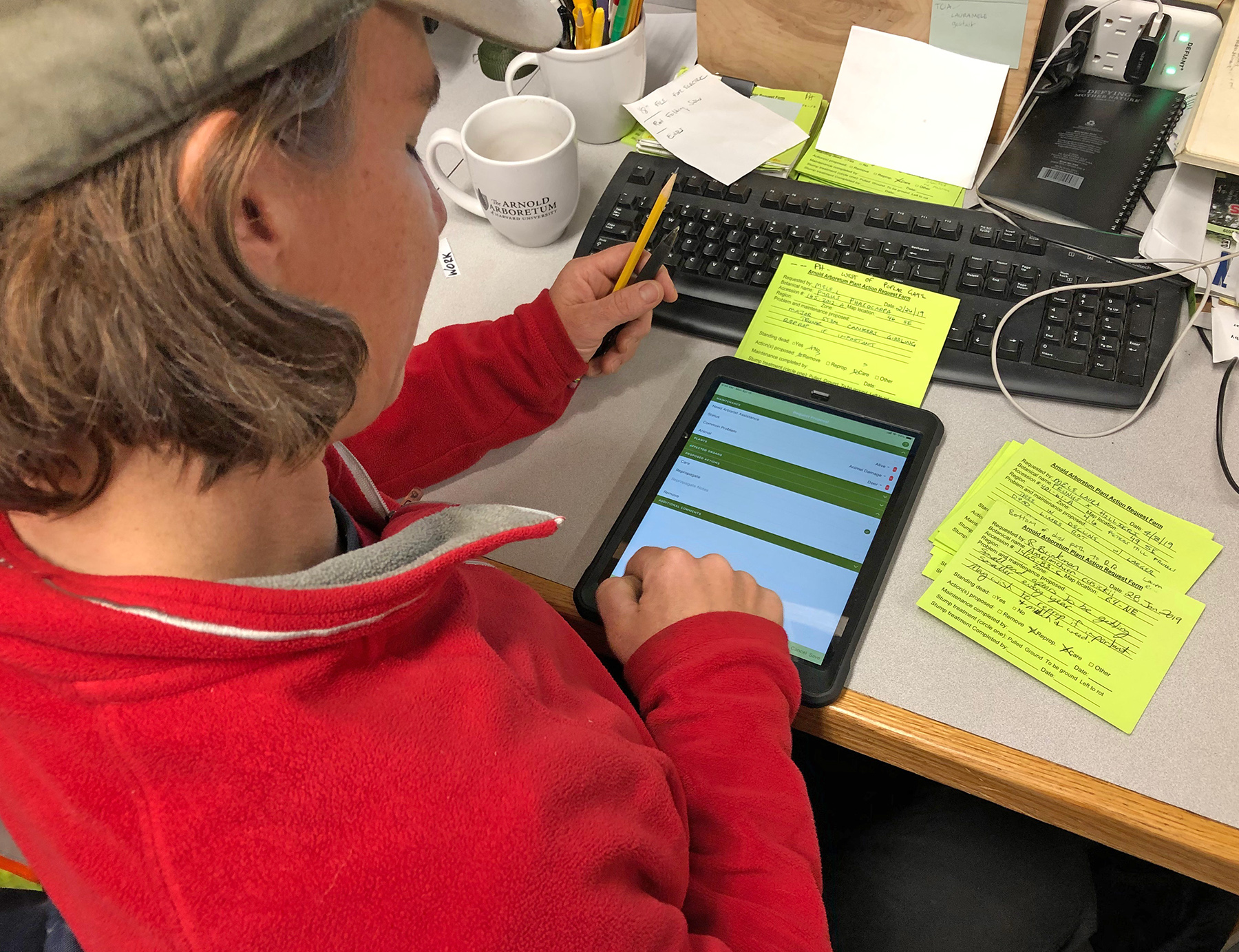New technologies connect our staff with the plants they steward
As we face the mounting threats of climate change—from new invasive pests and diseases to increased droughts and more extreme weather events—horticultural care at the Arnold Arboretum must adapt to address new challenges as they arrive. In response, the Arboretum has adopted an adaptive management perspective—we observe, study, and monitor our living collections with an eye towards continuous adjustment and improvement of their care. As an Arboretum Living Collections Fellow, I’ve spent the last two years translating this perspective into a suite of tools called the Landscape Management System (LMS) that integrate adaptive management into our day-to-day work through new mobile applications, websites, updated mapping information, and more.
Working with a team of horticulturists, curatorial staff, and IT developers, we set out to build a new mobile application called ArbManager, which transforms how our staff communicates and shares information about horticultural issues in our living collections. Using ArbManager, staff members can report and communicate about plant care needs like pruning, pest control, mulching, etc. using a smartphone or other mobile device.
Historically, communication around these issues had been tracked on paper cards, known due to their color as green cards, but passing around cards led to delays, lost information, and difficulty in interpreting the many different opinions recorded by the staff. ArbManager makes this communication instantaneous and streamlines decision making among the multiple staff members who need to be involved in key horticultural decisions.

The new ArbManager digital green cards include photographs, GPS coordinates, and standardized language to describe plant care issues along with new map interfaces and the ability to report phenological observations like fall color or budbreak. Perhaps most importantly, each time a staff member enters information into ArbManager, those data are automatically transferred to BG-BASE, the Arboretum’s plant records database. This new linkage represents a major technological achievement in connecting the Arboretum’s various databases and allows ArbManager data to be preserved (like all of our plant records), forever. These snapshots in time—what diseases are most prevalent in a particular area, or which species seem most prone to winter damage—give us a vast new set of data we can use to adapt our practices and ensure the longevity of the collection.
Next, to further improve communication and centralize access to key horticultural information, our team developed a new website, known as the ArbDashboard, that gives the horticulture staff instant access to the vast trove of plant health reports, maps, current and historical management plans, and even Arnoldia and Silva articles that pertain to the management of the collection.
Using the ArbDashboard, staff members can visualize key plant information, infrastructure, and natural features on the digital map, read about and update the maintenance requirements for each of the Arboretum’s 91 horticultural management zones, track plant health issues or scouting efforts, and download key articles or reports—all from one central website. Through this improved accessibility and transparency, the ArbDashboard provides the staff with all the background information they need to make the best horticultural decisions in the landscape and ensures the highest quality of care for our plants.

By improving communication about landscape issues with ArbManager and bringing previously disparate information together in one place with the ArbDashboard, we believe the Landscape Management System will help us transform our horticultural practices at the Arboretum to meet the challenges of the 21st century. Using these new tools, guided by an adaptive management framework, a horticulturist can report a pest infestation in the landscape, managers can assemble all the pertinent background information they need, and together they can develop a solution—all within minutes.
As one of the country’s first public arboreta, the Arnold Arboretum has long shared its methods and successes with other public gardens around the world. With the development of the LMS, we see a wonderful opportunity to encourage other institutions to adopt similar types of adaptive management systems and to share some our technological advancements.
Head of Horticulture Andrew Gapinski and I described the project to the public garden community through a presentation to the 2020 virtual American Public Garden Association conference in June; the surge of enthusiasm we received afterwards only encouraged us to continue working hard not just for the Arnold, but for the entire public garden community.
ArbManager and the ArbDashboard are just the first components of the LMS—currently, our committee is focused on how to bring some of these adaptive management principles to the Dana Greenhouses, where the plant production department oversees the movement of thousands of plants—from mist houses and greenhouse benches to the outdoor nurseries and finally into the landscape of the Arboretum—and collects vital data along the way. Our project is far from over and, like the collection we seek to maintain, will always be changing to address the current climate.
From “free” to “friend”…
Established in 1911 as the Bulletin of Popular Information, Arnoldia has long been a definitive forum for conversations about temperate woody plants and their landscapes. In 2022, we rolled out a new vision for the magazine as a vigorous forum for tales of plant exploration, behind-the-scenes glimpses of botanical research, and deep dives into the history of gardens, landscapes, and science. The new Arnoldia includes poetry, visual art, and literary essays, following the human imagination wherever it entangles with trees.
It takes resources to gather and nurture these new voices, and we depend on the support of our member-subscribers to make it possible. But membership means more: by becoming a member of the Arnold Arboretum, you help to keep our collection vibrant and our research and educational mission active. Through the pages of Arnoldia, you can take part in the life of this free-to-all landscape whether you live next door or an ocean away.

